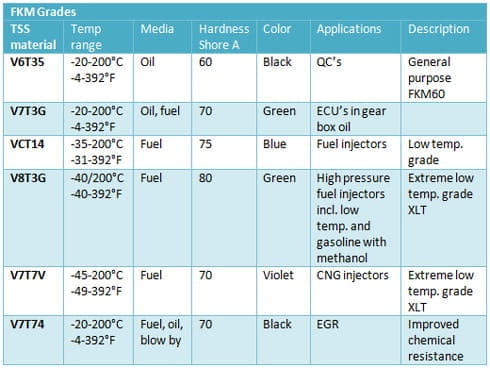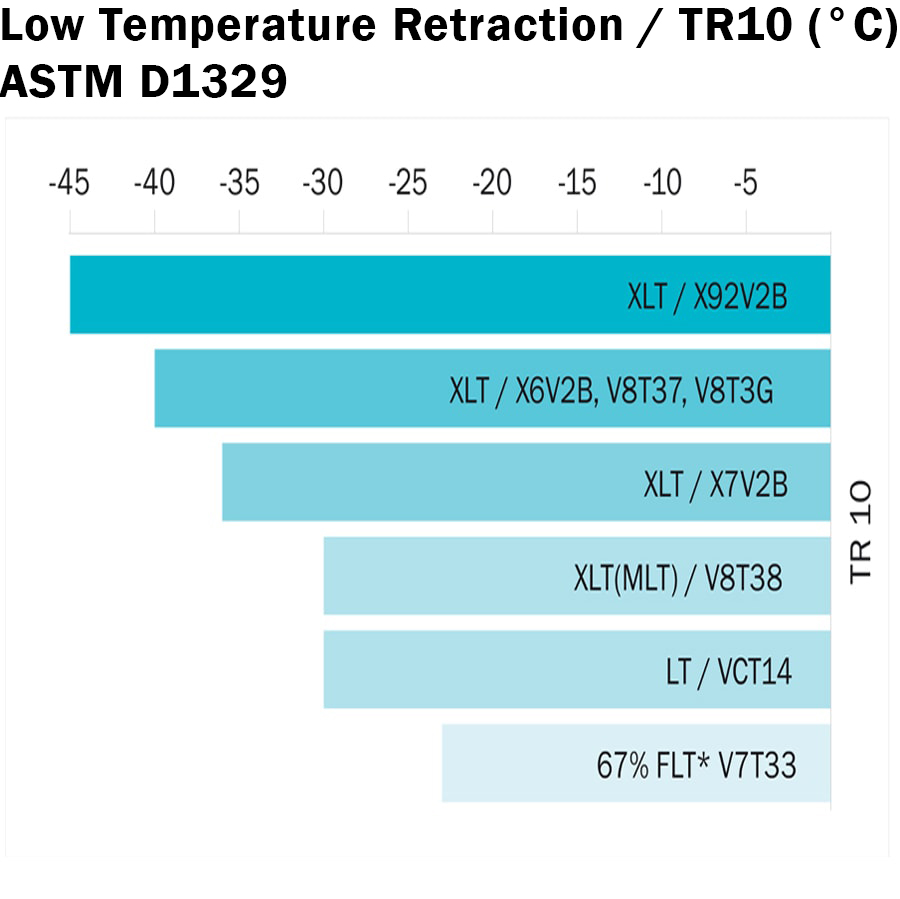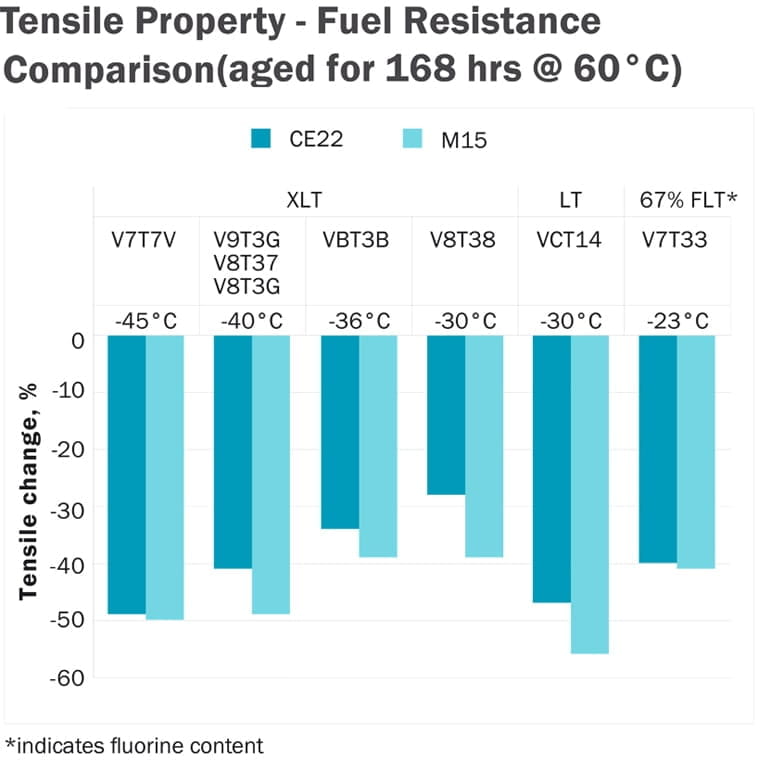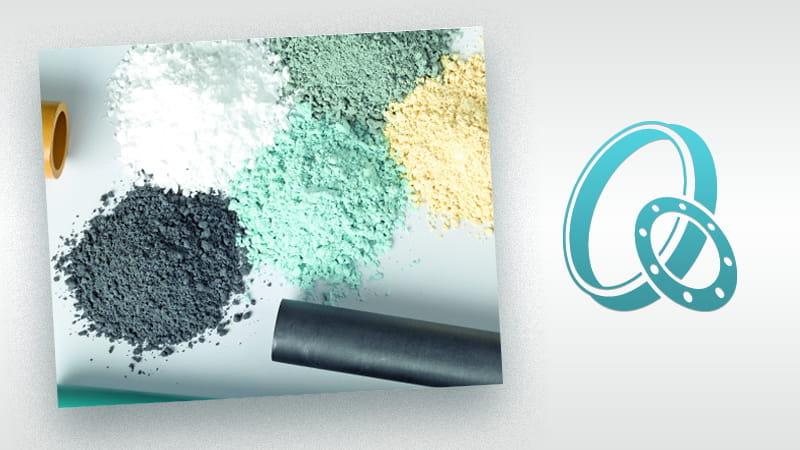材料

憑藉數十年的經驗,與全球領先的設備製造商和最終用戶合作,我們開發了一系列非常適合汽車應用的材料。 從基本的彈性體等級到領先的高規格化合物; 我們的創新密封材料有助於優化性能,同時確保密封完整性。
汽車行業的具體材料問題
趨勢 - 議題- 發展
燃料變化 - 生物燃料比傳統燃料對彈性體的侵蝕性更強 - 耐生物燃料材料
排放法規變得更加嚴格 - 減少顆粒物和 NOX - 選擇性催化還原材料 (Adblue)
需要更高的效率 - 更高的溫度和壓力 - 能夠承受極端溫度的材料
請注意:以下內容由翻譯軟體自動翻譯,詳細資訊請見原文內容。
乙烯/丙烯酸彈性體 (AEM)

AEM 耐油、耐熱、耐臭氧。它對潤滑油和油脂(礦物或含有腐蝕性添加劑的合成油)、變速箱/動力轉向液、高達 100°C/212°F 的水俱有良好的抵抗力,並且在特殊情況下還能抵抗乾濕酸性氣體和 Blow-By 現象。AEM 的工作溫度範圍為 -40°C/-40°F 至 160°C/320°F,短時間內可高達 190°C/374°F。 AEM 填補了 HNBR 和 FKM 之間的不足。
該材料具有:
- 優異的耐候性和耐臭氧性
- 非常好的耐熱性
- 低永久變形量
- 耐大多數油、油脂(甚至含有腐蝕性添加劑)
- 良好的低溫性能
應用:
AEM 的典型應用是與油接觸的所有類型的靜態密封,例如齒輪箱、油泵、凸輪蓋或其他裝置中。特殊配方允許與 AdBlue® 接觸使用。
產品:
- 變速箱、凸輪蓋和油底殼墊片的 ECUs
- AdBlue® 噴射器或 QC
三元乙丙橡膠 (EPDM)

由於具有飽和的聚合物鏈,EPDM 具有非常好的耐熱、耐臭氧和耐老化性能。此外,它還表現出優異的低溫性能以及良好的絕緣性能。 EPDM 的應用工作溫度範圍為 -45°C/-49°F 至 150°C/302°F,短時間內可高達 175°C/347°F(對於硫磺固化類型,範圍降至 130°C/266°F)。
該材料具有:
- 優異的耐候性和耐臭氧性
- 優異的抗磷酸酯性能
- 具有良好的抗氧化化學品(酸)和煞車油性能
- 在水中膨脹率低
- 出色的耐高溫和耐蒸汽性能,最高耐溫可達 180°C
- 良好的耐熱老化性能
- 優異的低溫性能
應用:
EPDM 通常用於煞車油(基於乙二醇)的應用,作為與冷卻劑接觸的散熱器墊圈,作為空調中密封冷媒的 O-rings 或僅作為防塵密封件。
產品:
O-rings, 墊片
氟化橡膠 (FKM)

在汽車應用中,FKM 尤其以其極佳的耐燃料、耐油和耐腐蝕介質性能以及優異的耐臭氧、耐候和耐老化性能而聞名。根據結構、氟含量和所使用的固化系統,FKM 材料在耐化學性和冷柔性方面會有所不同。 FKM 的工作溫度範圍為 -20°C/-4°F 至 200°C/392°F,短時間內可高達 230°C/446°F。
特殊 FKM 等級可在低至 -45°C/-49°F 的溫度下使用。
該材料具有:
- 耐油脂
- 非常好的耐燃油性
- 優異的耐熱性
- 優異的耐候性和耐臭氧性
- 耐酸性好
應用:
由於具有較高的耐化學性和在燃料中的低膨脹性(特別是含有乙醇和甲醇時),FKM 通常可以在整個燃料供應鏈中找到(燃油噴射器、快速連接器、高壓泵等)。此外,變速箱 ECUs 中的墊片也是一個應用領域。
產品:
氟化矽膠 (FVMQ)

FVMQ(氟矽酮)具有良好的耐熱性、極佳的低溫柔韌性以及優異的耐候性、耐臭氧性和耐紫外線性。 FVMQ 具有比標準矽膠 (VMQ) 更好的耐化學性,尤其是與碳氫化合物、芳香族礦物油和燃料一起使用時。與 VMQ 相比,溫度範圍略有降低,從 -50°C/-58°F 到 180°C/356°F。
該材料具有:
- 非常好的耐化學性
- 極佳的耐燃油和耐油性能
應用:
該材料的主要應用是 CNG 噴射器和燃油導軌快速連接器
產品:
O-rings, membranes
氫化丁腈橡膠 (HNBR)

HNBR 是透過對 NBR 丁二烯基團進行選擇性加氫而製成的,這大大提高了其耐高溫和耐臭氧性能。由於聚合物結構,HNBR 可抵抗極性和非極性介質。專用汽車應用的選擇取決於 ACN 含量(範圍從 18% 到 50%)(這會影響油中的膨脹),以及飽和度(這會影響耐熱性)。 HNBR 具有極佳的機械性能和耐磨性。與礦物油和油脂接觸時的工作溫度範圍為 -30°C/-22°F 至 140°C/284°F,短時間可達 +160°C/320°F。特殊類型可在低至 -40°C/-40°F 的溫度下使用。
該材料具有:
- 耐高溫達 140°C
- 卓越的耐環境性
- 提高對極性流體的抵抗力
應用:
由於具有良好的耐磨性和耐油性,主要應用是齒輪箱應用的執行器密封件。此外,HNBR 也常用於空調應用
產品:
唇式密封件, O-rings, 靜態密封件
丁腈橡膠 (NBR)

與 HNBR 一樣,丁腈橡膠 (NBR) 的特性主要取決於 ACN 含量,範圍為 18% 至 50%。總體而言,NBR 具有相當好的機械性能。由於不飽和聚合物鏈,最高工作溫度限制為+100°C/212°F(短時間內可達120°C/248°F),而最低溫度可降至-30°C/-22°F(使用適當配方的NBR可低至-50°C/-58)。
該材料具有:
- 耐油性好
- 中等耐熱性,油中 125°C / 空氣中 100°C
- 高拉伸強度和撕裂強度
- 耐磨性好
- 性價比高
應用:
由於具有出色的耐磨性,NBR 被廣泛用於與礦物油和油脂接觸,作為與 PTFE 密封件 一起使用的 Energizers 或減震器中。
產品:
矽膠 (VMQ)
Turcon® M12: 高性能聚四氟乙烯 PTFE

特瑞堡密封系統公司的 Turcon® M12 是一種基於 PTFE 的密封材料,其在摩擦、磨損和高壓操作等關鍵液壓密封特性方面具有無與倫比的性能。
綜合測試表明,沒有其他基於 PTFE 的材料能夠提供如此普遍的卓越性能。
Turcon® M12 現已被特瑞堡密封系統推薦為各種汽車液壓應用的首選材料,包括:
- 敞篷車油缸
- 避震器
- 主動車身控制

- 避免表面上劃傷
- 低摩擦力使運動平穩
- 承受高系統壓力
- 出色的耐磨性
- 良好的抗擠壓性
- 耐受幾乎所有介質,包括各種潤滑劑
- 延長密封壽命
該圖顯示了在同一測試室中彼此相對放置的兩個密封件的摩擦特性。 Turcon® M12 的摩擦力約為 T40 摩擦力值的一半。 這些測試結果證明 Turcon® M12 具有最低且最一致的摩擦特性。
XLT 材料

XLT 系列是特瑞堡密封系統公司最新推出的創新低溫過氧化物固化氟橡膠系列。 XLT 的設計專門滿足了汽車應用的嚴苛要求,並且適用於高壓直接噴射應用。
影響彈性體密封材料的汽車趨勢
- 燃料變化-材料需要能夠抵抗生物燃料,因為生物燃料對彈性體的侵蝕性比傳統燃料更強。
- 嚴格的排放法規-密封件必須承受不同的介質,例如用於選擇性催化還原的 Adblue。
- 更高的效率-材料必須能夠耐受更大的溫度範圍和極端壓力。
- 回彈 (TR10) 值範圍從 -30 °C 至 -45 °C / -22 °F 至 -49 °F
- 增強耐化學性,特別是對腐蝕性乙醇和甲醇燃料混合物
- 提高引擎等惡劣環境下的密封能力
- 優異的機械性質保持性
高壓直噴燃油
新一代 XLT 材料在生物燃料應用中的測試已證明,該系列材料的性能優於傳統氟碳彈性體,並擴展了其溫度性能能力,同時具有相對較低的體積膨脹和良好的物理性能保持性。它們還表現出對大多數介質的出色耐化學性,包括更具腐蝕性的乙醇/燃料和甲醇/燃料混合物。
優化的低溫行為
當 TR10 值達到 - 45 °C /- 49 °F 時,可達到優異的密封能力,優於其他氟碳彈性體。







